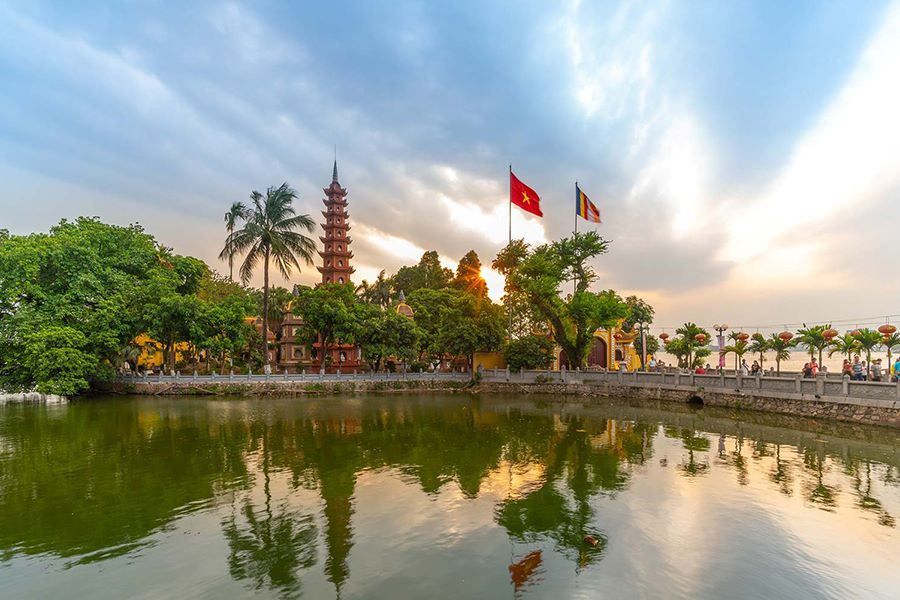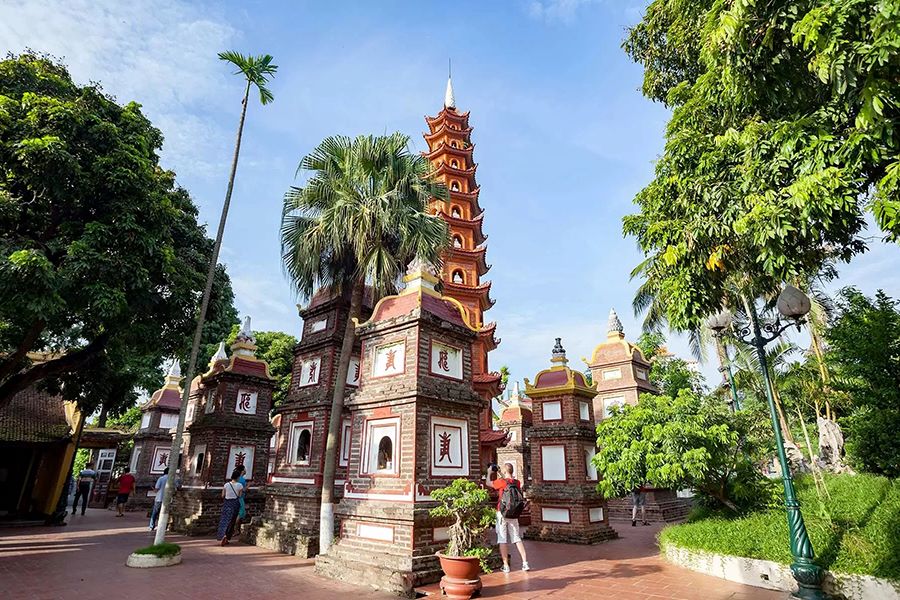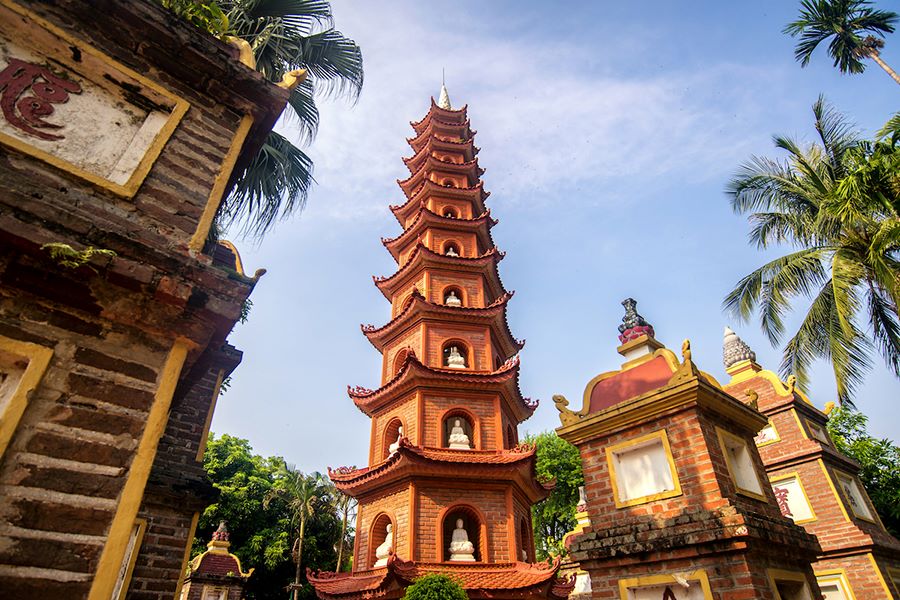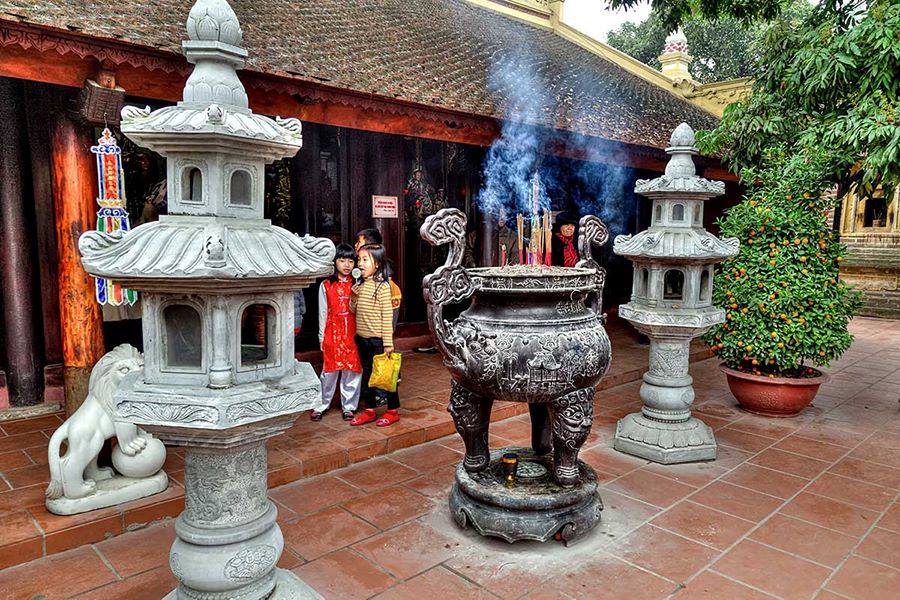When visiting Vietnam's capital, don't miss the breathtaking Tran Quoc Pagoda, which boasts important cultural elements, a serene atmosphere, and exquisite architecture. The oldest and most historically significant pagoda in Hanoi, Tran Quoc Pagoda, is a must-see attraction for travelers in their Indochina itinerary. This religious monument, a revered "gem" in the center of West Lake, is a must-visit location for any traveler interested in local culture while in the capital of Vietnam.
Tran Quoc Pagoda Location
Situated in Tay Ho District, Hanoi, on a small islet in West Lake is the Tran Quoc Pagoda. The pagoda's main gate, located at 46 Thanh Nien Street, allows visitors to enter the structure. Amitabha Buddha, Shakyamuni Buddha, and Avalokitesvara Bodhisattva are worshipped at Tran Quoc Pagoda. An altar honoring Guan Yu, Guan Ping, Zhou Shang, and Anathapindika is also present.
The Ho Chi Minh Mausoleum and the Temple of Literature, two of Hanoi's most popular sights, are both rather close to the Tran Quoc Pagoda. It provides an easy jumping-off point for discovering the gastronomic and cultural attractions of the city. The area surrounding Tran Quoc Pagoda is replete with breathtaking views that are sure to enchant visitors.
History of Tran Quoc Pagoda
The oldest pagoda in Hanoi is Tran Quoc Pagoda, which dates back 1,500 years. Originally known as the Khai Quoc Pagoda, it was constructed in 541 during the Early Ly Dynasty. The pagoda was then situated close to the Red River's banks. The pagoda was moved to Yen Phu dyke in the Kim Nguu mound area in 1615 after the dyke collapsed.
During the reign of King Le Hy Tong (1681–1705), the pagoda was renamed Tran Quoc in the hopes that it would shield people from natural disasters and provide them with a serene existence. Even now, the term "Tran Quoc" is in usage.
Architecture of Tran Quoc Pagoda
The Tran Quoc Pagoda preserves the exquisite grandeur of Eastern architecture while adhering to the rigid precepts of Buddhism.
A perfect fusion of traditional components, the 3000-square-meter pagoda's design is defined by its detailed woodwork, gracefully curving roofs, and delicate embellishments. Every little thing bears witness to Buddhism's compassion for the natural world and quest for spiritual equilibrium.
The 11-Storey Stupa
The 11-story Stupa, also known as Bao Thap, is a magnificent red-brown tower that rises majestically before you as soon as you enter the pagoda. This magnificent tower, which has eleven separate stories with six tastefully arched doors on each, is an enthralling masterpiece.
White gemstone statues of Amitabha Buddha stand in quiet adoration inside these entrances, exuding a calm, enlightened atmosphere. The Buddha sculptures inside the entrances act as a reminder of the teachings of the Buddha and the way to enlightenment.
The Front House
You will see numerous distinctive statues as soon as you enter the Tran Quoc Pagoda's Front House. Among them is the wooden figure of Shakyamuni Buddha painted in a lustrous golden hue. It is with great honor that this specific statue has been voted Vietnam's most beautiful Lying Buddha statue.
The passion and expertise of the artists who crafted this magnificent monument are evident, and it also perfectly embodies the core teachings of the Buddha: transcendence, serenity, and the search for inner peace.
You are welcome to ponder the profound significance of the Buddha's life and teachings as you stand in front of this statue. You may also want to take a minute to yourself to find some peace amidst the spiritual atmosphere of Tran Quoc Pagoda.
The Incense Burning House
One of the lively hubs of the Tran Quoc Pagoda, the Incense Burning House attracts a constant stream of tourists and fosters a lively sense of bustle. You can pray for health and good fortune here by burning incense and other votives. The purification of intentions and the elevation of prayers to higher planes are symbolized by the burning of incense. You should give this beloved practice a try.
The Upper House
There is a bell post behind the Upper home that was intended to be a three-compartment timber home with a red tile roof. One other fascinating item on the pagoda grounds is the Stele House, which is located to the right of the bell post.
Together, the bell post and the Stele House provide an intriguing scene rich in architectural and historical detail.
The Stele House
Fourteen steles bearing poetry by well-known academics from that era are preserved in the Stele House. The Tran Quoc Pagoda's history is also documented in the steles, which include a detailed account of the pagoda's modifications throughout several dynasties. The following generations will be able to learn more about the history of the Tran Quoc Pagoda from the very beginning thanks to this knowledge.
The Bodhi tree is another feature that visitors to Tran Quoc Pagoda shouldn't miss.
Vietnam received a 1959 gift of a Bodhi tree from India's former president Rajendra Prasad at Tran Quoc Pagoda. The Great Bodhi Gaya tree, where Shakyamuni Buddha sat and practiced over 25 centuries ago, is where it was taken from. Don't pass up the opportunity to stand under the shadow of this revered tree and feel the atmosphere fill you with peace and reverence.
Tran Quoc Pagoda Opening Hours – Entrance Fee – Dress code
Opening hours:
- Everyday: 8 AM - 4 PM
- The 1st and 15th days of every lunar month: 6 AM - 6 PM
Entrance Fee: Free
Dress code: Formal, cover-up attire (no tank tops, shorts, or miniskirts)
Unquestionably one of the best tourist destinations in Hanoi, Tran Quoc Pagoda is a must-see due to its lengthy history, striking architecture, and exceptional cultural qualities. When tourists visit this place of worship, they can pray for their loved ones and become fully immersed in the serene surroundings.





